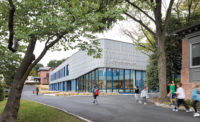Brooklyn Bridge Park Boathouse by Architecture Research Office
Brooklyn, New York

The metal grill wrapping the second story of the boathouse complements the operable metal gates below.
Photo © Elizabeth Felicella

The materials were chosen for durability and how they reference the surrounding Michael Van Valkenburgh–designed Brooklyn Bridge Park.
Photo © Elizabeth Felicella

A riprap berm rises at the rear of the structure.
Photo © Elizabeth Felicella

A metal-grate walkway leads to the upper garage-door entry, allowing light to reach the boat storage below.
Photo © Elizabeth Felicella

At night, cool LEDs illuminate the facade’s metal grill, while warm interior lighting reveals the wood-lined space above.
Photo © Elizabeth Felicella

Image courtesy Architecture Research Office

Image courtesy Architecture Research Office

Image courtesy Architecture Research Office








Architects & Firms
"This boathouse has the best view in the world,” says architect Stephen Cassell, gazing out the window of the Brooklyn Bridge Park Boathouse he designed with Adam Yarinsky, a fellow principal at Architecture Research Office (ARO). With an enviably clear sight line across the East River to Lower Manhattan, the simple structure is home to a variety of functions: free public kayaking programs, a pilot for a potential park information center, and new public bathroom facilities beyond other existing ones. “You can never have too many bathrooms in a park,” explains Eric Landau, president of the Brooklyn Bridge Park Corporation.
Additional Content:
Jump to credits & specifications
Master-planned by Michael Van Valkenburgh Associates in 2005, Brooklyn Bridge Park stretches along 1⅓ miles of the New York borough’s waterfront and is nearing 90 percent completion, Landau says, about a decade after construction began. When it came time to build on the Pier 5 uplands in 2014, ARO took a bold approach in responding to the competition brief for one building to house boating programs as well as maintenance and operations facilities: divide the public-facing and behind-the-scenes functions into separate structures, using the park’s signature landscape feature, the berm, to site them.
Their proposal tucked the maintenance-and-operations building behind a curve of a Van Valkenburgh–designed berm, an intervention that deflects sound from the nearby Brooklyn–Queens Expressway. Then, using a large model built by the landscape architects as a guide, ARO developed a scheme for the boathouse, ultimately nestling two stacked boxes totaling about 5,000 square feet into the riprap berm.
Referencing the park’s design and the area’s industrial past, the materials are rugged and off-the-shelf. “There is nothing custom here,” says Cassell, citing materials like the aluminum grating system that wraps the structure. “These buildings evolve—everything needs to work five different ways.” So, he adds, ARO’s goal was to “make something that was simple, durable, and can be adapted, without being fussy.”
Despite their simplicity, the materials are used to dramatic effect. Visitors are treated to views of the park and Manhattan skyline from both levels of the boathouse. Open, operable grate panels, around three sides and accessible from the park’s promenade, filter light and air into the boat-storage area at grade. The multiuse second floor—raised safely above FEMA flood-guideline levels—can be accessed by way of a series of sloping paths and stairways that meet near the top of the berm. There, a glazed garage-door entrance opens to a plywood-lined room where city and park views fill floor-to-ceiling low-E windows on its south and west elevations. Cement board panels block out views of less picturesque neighbors, like a Metropolitan Transit Authority (MTA) airshaft just beyond the park’s boundaries.
The MTA provided a complex—if invisible—engineering challenge as well. The boathouse is located within the zone of influence of an underground subway tunnel, and, since much of the parkland is landfill, the soil is prone to liquefaction. Collaborating with structural-engineering firm Leslie E. Robertson Associates and geotechnical firm Mueser Rutledge, the architects were able to avoid placing weight on the tunnel by supporting the simple galvanized-steel frame building with some 45 piers, reaching roughly 40 feet deep. “There’s a lot more structure under this than one would imagine for a tiny little building,” Cassell says.
As much attention as the design team paid to the building’s details, care was also given to the way it would be viewed from a distance, an experience that shifts as the sun washes over the metal grill, which also serves as a brise soleil. “It changes every minute,” says the project’s lighting designer, Linnaea Tillett. “The building has a lot of poetry.”
Tillett’s firm illuminated the boathouse with LED strip lights outside and linear interior fixtures. The color temperature follows the building’s shift from cool galvanized steel exterior to warm plywood, creating what Tillett describes as a “quiet lantern” nestled within the park. “We wanted it to sit very, very quietly—a lantern that illuminates the landscape around it but doesn’t demand you look at it.”
CreditsArchitect: Architecture Research Office — Stephen Cassell, Adam Yarinsky, principals in charge
Engineering: Leslie E. Robertson Associates (structural); Altieri Sebor Wieber (m/e/p); Sherwood Design Engineers (civil); Mueser Rutledge (geotechnical)
Consultants: Michael van Valkenburgh Associates (landscape architect); Tillett Lighting Design Associates (lighting design) |
SpecificationsCladding American Fiber Cement; Custom Exterior Systems; Ohio Gratings
Glazing Vitro Architectural Glass; Futureshock Architectural Metals & Glass
Fenestration YKK AP; Clopay; Overhead Door Company |













